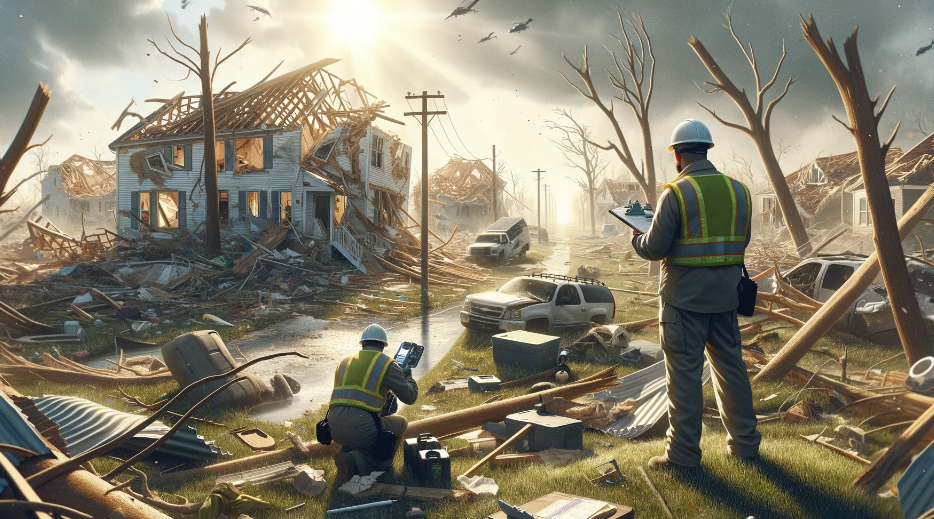Introduction: Tornadoes, known for their destructive power and unpredictable nature, are one of the most intense atmospheric phenomena. In this educational post, we delve into the world of tornadoes, examining their characteristics, how they form, their impacts, and essential safety precautions.
Characteristics of Tornadoes: Tornadoes are distinguished by several key features:
- Rapid Rotation: Tornadoes consist of violently rotating columns of air extending from thunderstorms to the ground – or vice-versa
- Variability in Size and Strength: They can range from a few yards wide to over a mile in width and vary significantly in strength, measured on the Enhanced Fujita Scale.
- Wind Speed: Tornado winds can exceed 300 mph, making them capable of causing extreme destruction to even the sturdiest of buildings
- Path and Duration: The path of destruction can be over 50 miles long, though most tornadoes are on the ground for less than a few miles, lasting less than 10 minutes.

Formation of Tornadoes: Tornadoes form under specific atmospheric conditions, often associated with severe thunderstorms:
- Supercell Thunderstorms: Most strong and violent tornadoes form within supercell thunderstorms, which have strong rotating updrafts.
- Wind Shear: Variations in wind speed and direction at different altitudes can contribute to the rotating motion needed for tornado formation.
- Instability: Warm, moist air near the ground and cooler air above create instability, which can lead to strong updrafts and the development of tornadoes.
- Downdrafts: Further enhancing the rotation already caused by wind shear, downdrafts interact with air at the surface and can lead to the tilting of air at the surface into a vertical position, a critical step in the formation
Impacts of Tornadoes: The effects of tornadoes can be devastating and far-reaching:
- Destruction: Tornadoes are capable of causing immense destruction. Their high-speed winds can demolish well-constructed buildings, uproot mature trees, and transform everyday objects into deadly projectiles. The intensity of these winds can lead to fatalities and injuries, making tornadoes one of the most destructive natural disasters.
- Displacement: The aftermath of a tornado often includes the widespread destruction of homes and key infrastructure. This devastation can displace entire communities, forcing people to seek temporary or long-term shelter elsewhere. The loss of homes and community structures profoundly disrupts daily life and can have long-term socioeconomic consequences for the affected areas.
- Economic Loss: The economic impact of tornadoes extends far beyond the immediate damage. It encompasses the cost of rebuilding and repairing infrastructure, the loss of business and agricultural productivity, and the strain on local and national emergency response resources. Insurance claims and government disaster relief efforts, while helpful, often only cover a portion of the total losses, leading to significant financial burdens on affected individuals and communities.
- Psychological Impact: Surviving a tornado or living in a tornado-prone area can have profound psychological effects. This includes Severe Weather Anxiety, a condition characterized by intense fear and anxiety about potential weather threats. People may experience post-traumatic stress, depression, and anxiety disorders following a tornado event. The uncertainty and unpredictability of tornadoes, along with their potential for catastrophic damage, contribute to ongoing stress and fear among residents in susceptible regions.

Safety Measures During Tornadoes: Preparing for and responding appropriately to tornadoes is crucial for safety:
- Warning Systems: Pay attention to tornado watches and warnings issued by weather services. And have a weather app on your smartphone and a NOAA Weather Radio to ensure you’re alerted when a warning is issued.
- Shelter: Seek shelter in a basement or an interior room on the lowest floor of a sturdy building, away from windows.
- Tornado Plan: Have a tornado safety plan in place and practice it regularly with your family.
- Emergency Kit: Keep an emergency kit with essentials, including water, non-perishable food, a flashlight, and a first-aid kit.
- Stay Informed: Use the same weather apps and NOAA Weather Radio to keep up with the storms as they pass.
Take Home: Tornadoes are a formidable force of nature, characterized by their unpredictable and destructive potential. Understanding their characteristics, formation process, and impacts, along with adhering to safety guidelines, is vital for those living in tornado-prone areas.
This exploration of tornadoes aims to provide valuable knowledge and highlight the importance of preparedness and responsiveness. For further questions or topics of interest, feel free to reach out. Remember, safety and awareness are key when facing the threat of tornadoes.

